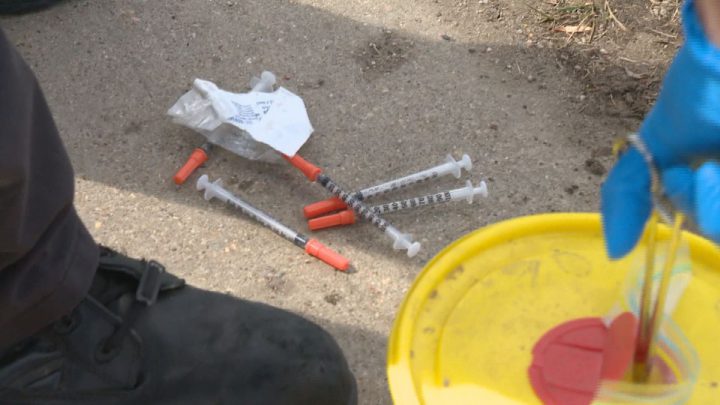A Saskatoon police officer was poked by a used needle while searching a stolen vehicle over the weekend, a hazard officials with the force say members face on a daily basis.

It’s also a risk to the public.
On average, the Saskatoon Fire Department (SFD) receives over 1,400 calls each year for sharps, and thousands of needles are recovered.
More than 4,600 syringes have been picked up off the streets so far in 2018.
SFD assistant chief Wayne Rodger said anyone finding a needle should call 306-975-3030 for crews to pick up.
Used needles can also be disposed of at needle drop boxes located around Saskatoon.
Twelve are located at community locations, and nine others are placed outside of fire halls.
There are steps that need to be taken to ensure the safe pick up and disposal of used needles:
- Do not recap the needle.
- Wear garden, work or medical gloves.
- Use tweezers, pliers or tongs to pick up by the end that is not sharp. Keep away from your body.
- Place the needle, sharp end first, into a hard container that needles cannot poke through (e.g. liquid laundry detergent or bleach container).
- Fill a container no more than 3/4 full. If the container is too full, the needles may poke through the side.
- Put the container lid on tightly and tape it.
- Wash your hands with soap and water.
- Store the container in a safe place away from children until you can dispose of it safely.
- Do not place needles in city garbage or recycling.
Anyone poked by a used needle should take the following steps:
- Encourage bleeding immediately and place your hand under running tap water to flush out the wound.
- Do not suck on the wound even if water is not available.
- Take careful note of the characteristics of the needle and injury (size, type, depth of penetration).
- Do not recap the needle.
- Contact your doctor or hospital emergency department as soon as possible.
- Package the needle in a hard-surfaced, enclosed container and take it to the emergency department with you.
-With files from Meaghan Craig



Comments